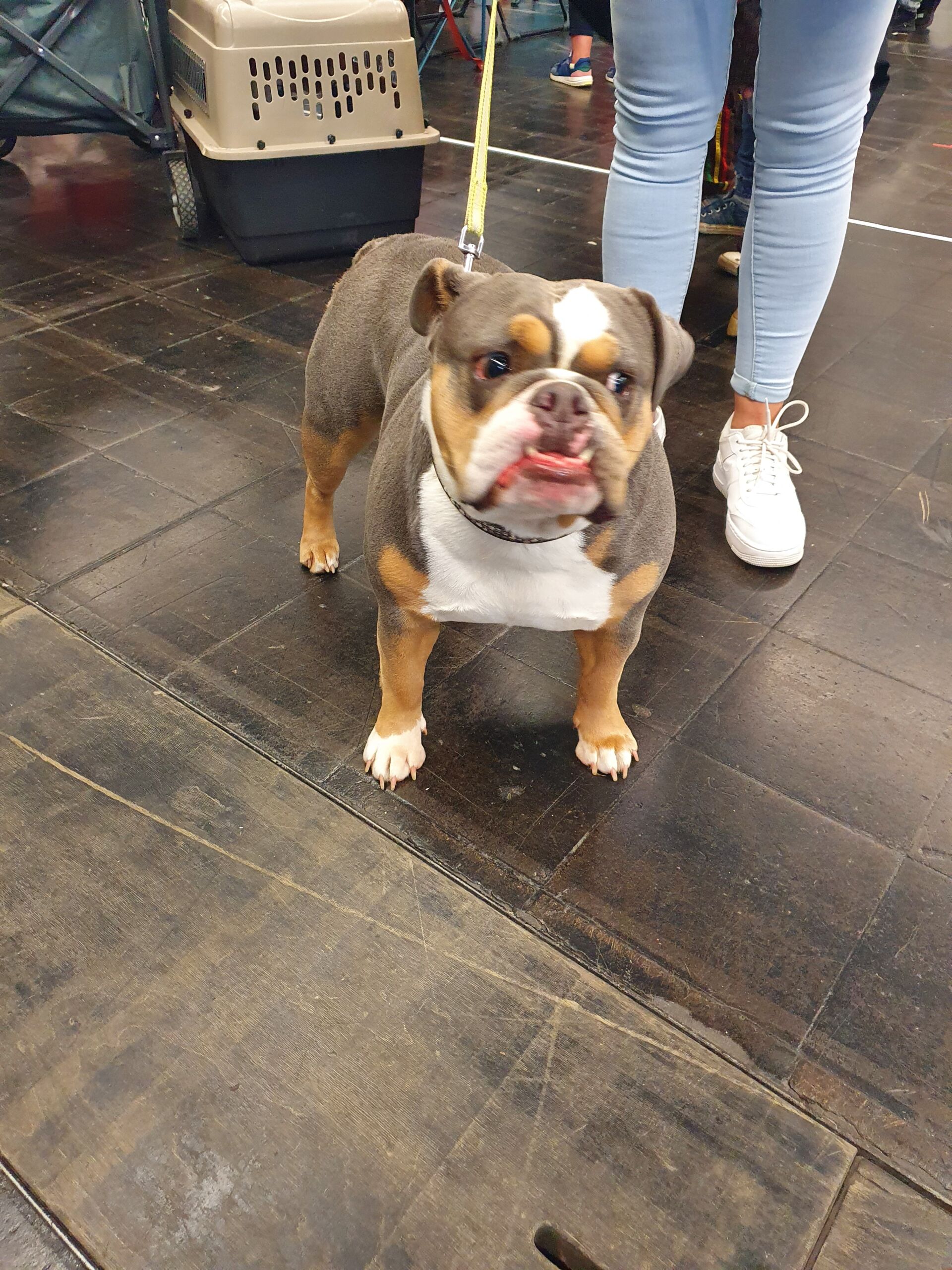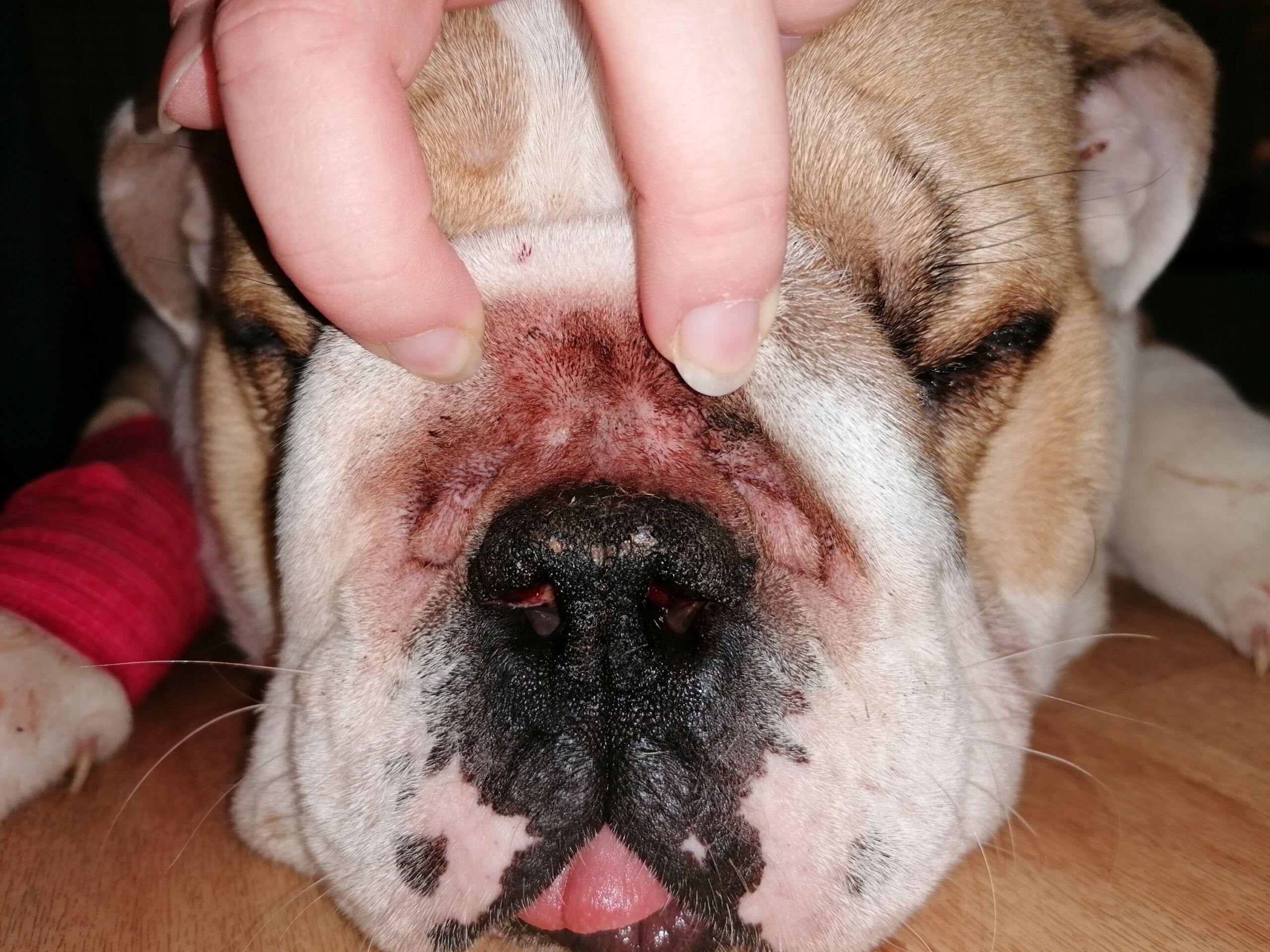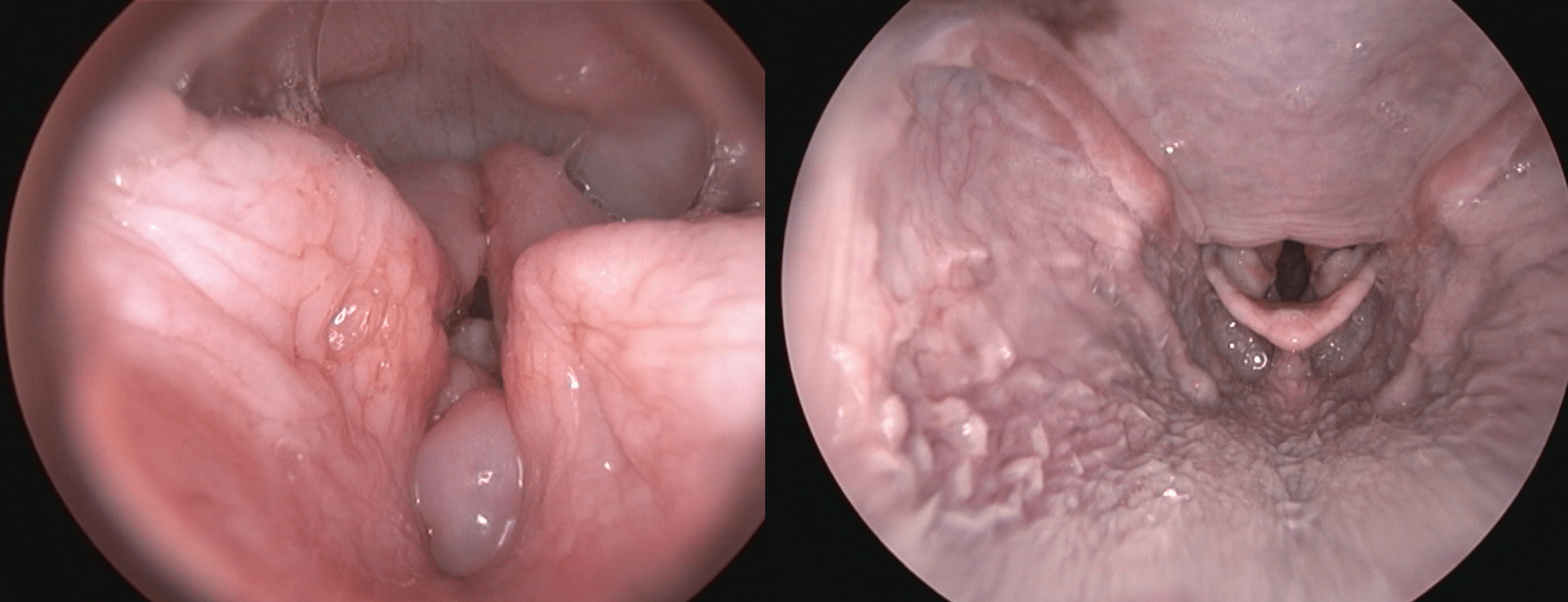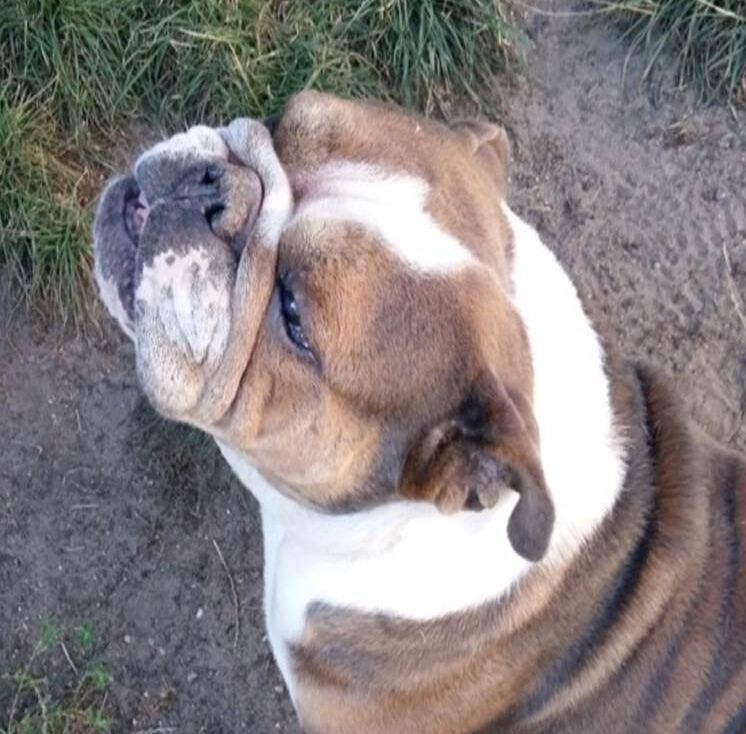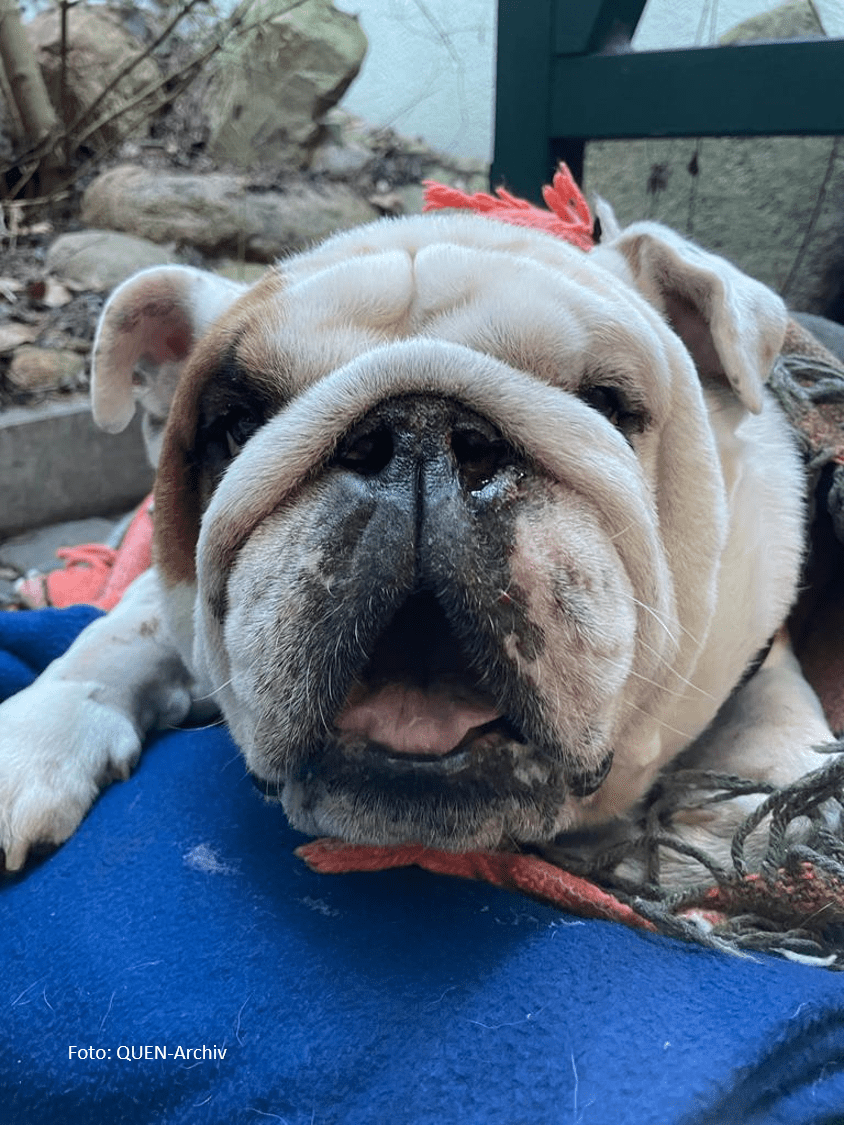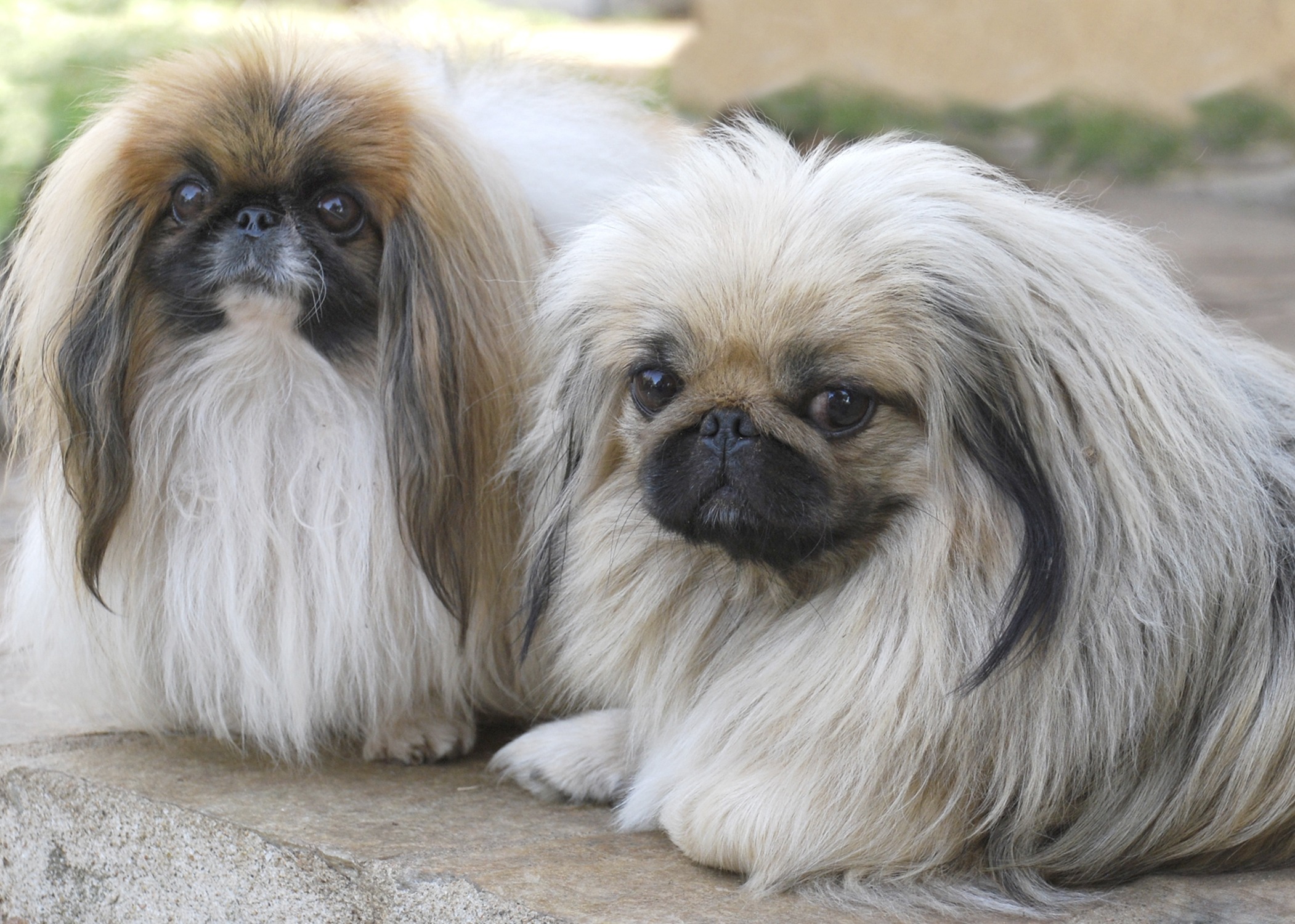Fact Sheet Dog Breed (English) Bulldog
Species: Dog
Breed: (English) Bulldog
QUEN-Fact Sheet Nr. 26-EN
Status: 05.06.2025
Species: Dog
Breed: (English) Bulldog
QUEN-Fact Sheet Nr. 26-EN
Status: 05.06.2025
1. Description of the animals
FCI breed standard* Nr. 149
External appearance and critical characteristics required by the standard:
According to the breed standard, Bulldogs are broadly built and compact. They have a large head with a short and blunt face, i.e. brachycephaly is required by the standard. The ears are folded and laid back. The loin is higher than the shoulder. The tail is malformed. The back is short, hind legs are longer than front legs.
Gait: does not lift the hind feet high so that they appear to graze the ground.
The breed is bred in various smaller and larger breeding associations within and outside the FCI.
∗In Germany the TierSchG and the TierSchHuV are legally binding for the assessment of the individual animal.
2.1 Picture 1
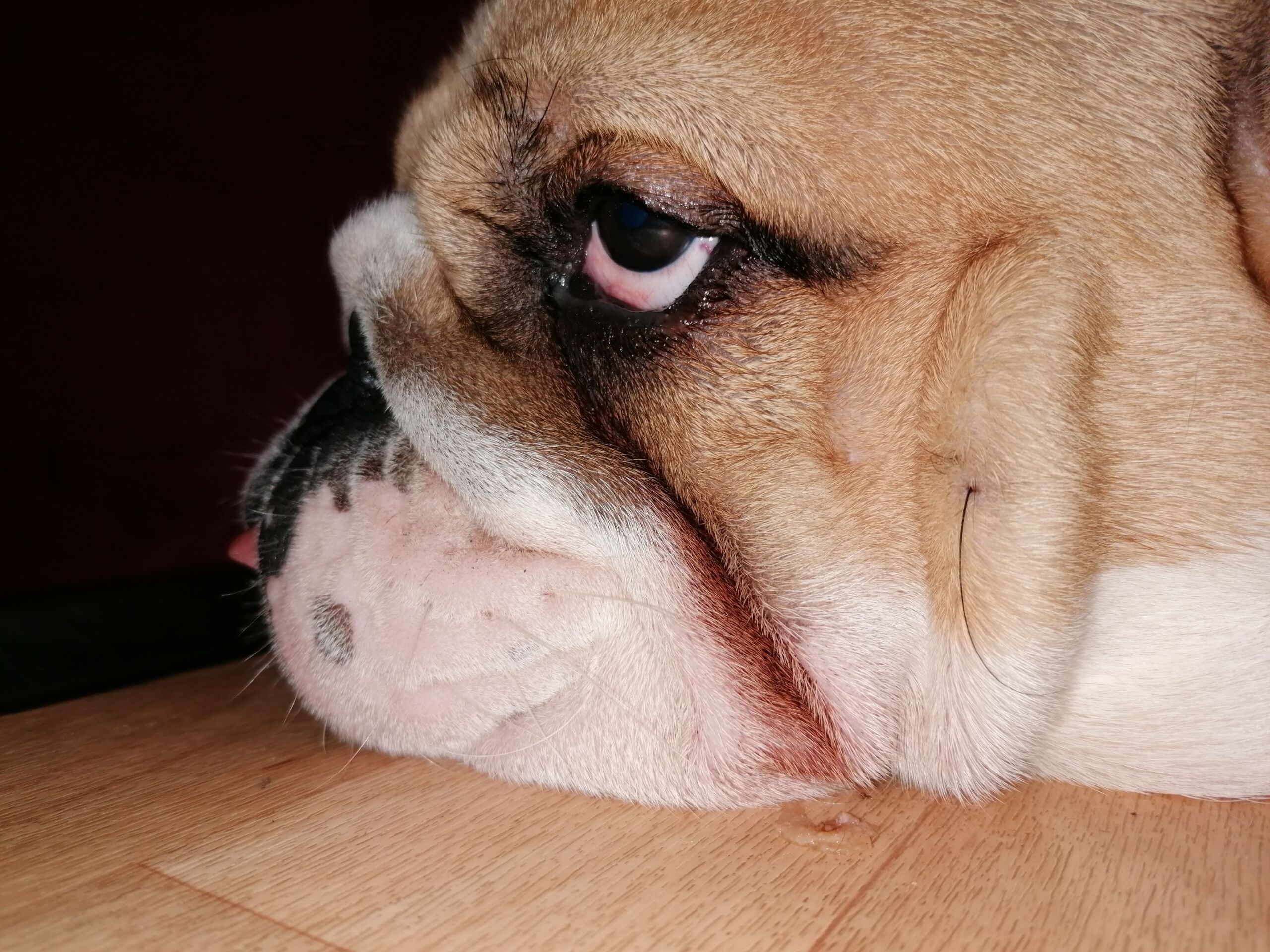
(English) Bulldog.
Photo: QUEN-Archive
2.1 Picture 2
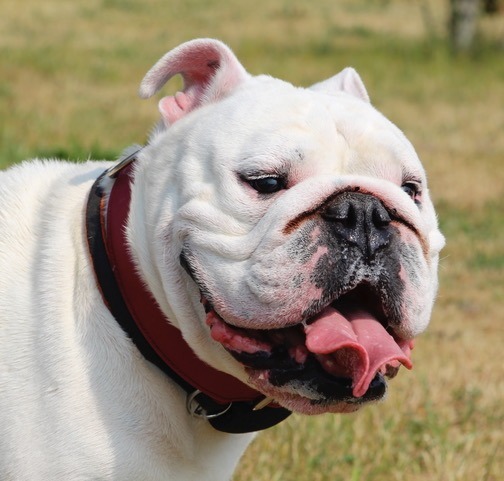
(English) Bulldog
Photo: QUEN-Archive
More pictures can be found here (click on picture):
Further image material can be found here:
(English) Bulldog: severe dyspnea due to brachycephalic obstructive airway syndrome (BOAS).
Video: QUEN Archive
3. Problems/syndromes that may be present in the breed
Of the several problems and possible diseases that occur in this breed, only the most important breed-typical defects are listed here.
The (English) Bulldog is known to have the following breed-typical defects or common problems/health disorders and dispositions*:
* (please also refer to the existing information sheets on individual defects such as brachycephaly, rod, entropion or Robinow-like syndrome)
- Robinow-like syndrome
- Brachycephaly
- BOAS (brachycephalic obstructive airway syndrome incl. tracheal hypoplasia)
- Difficulties giving birth (dystocia), high caesarean section rate
- Skin diseases (bacterial folliculitis, dermatitis and pyoderma due to skin folds, tail fold intertrigo, demodicosis, hyperkeratosis)
- Spinal defects (hemivertebrae, discospondylitis)
- Eye diseases (entropion, ectropion, keratoconjunctivitis sicca, cherry eye, ulceration of the cornea)
- Hip joint dysplasia
- Ear diseases
4. Other problems that may occur frequently
In addition to the breed-typical defects listed under point 3, the veterinary literature contains information on the occurrence of the following problems, which will not be discussed further below, as no definitive conclusions on prevalence can yet be drawn:
- Ectopic ureter
- Elbow dysplasia
- Hemophilia A
- Cardiovascular diseases (pulmonary stenosis, ventricular tachycardia, tetralogy of Fallot)
- Hiatal hernia (diaphragmatic hernia)
- Hydrocephalus
- Hypothyroidism
- Idiopathic head tremor syndrome
- Cryptorchidism
- Cleft lip/palate
- Patellar dislocation
- Primary splenic torsion
- Swimmer’s syndrome („swimming puppy syndrome“)
- Tumor diseases
- Urethral prolapse
- Urolithiasis
- Vaginal hyperplasia
5. Clinical signs and disease value of the typical defects mentioned above: Significance/impact on the physical/psychological well-being (burden) of the defect in the individual animal and classification in a burden category *
*The individual breeding-related defects are assigned to different burden categories (BC) depending on their degree of severity. The overall burden category is based on the most severe defect found on the individual animal. The BC system as a further development based on the Swiss model is currently still being developed, so the BC values given here are to be regarded as provisional.
The burden that can be caused by breeding characteristics are divided into 4 categories (Art. 3 TSchZV, Switzerland). The most burdenful trait or symptom is decisive for the assignment of an animal to a burden category (Art. 4 TSchZV, Switzerland).
Category 0 (no burden): these animals may be used for breeding.
Category 1 (mild burden): mild stress is present if a harmful manifestation of characteristics and symptoms in pets and farm animals can be compensated for by appropriate care, husbandry or feeding, without intervention in the animal and without regular medical care measures.
Category 2 (medium burden): these animals may only be used for breeding if the breeding objective is to ensure that the burden of the offspring is below that of the parent animals.
Category 3 (severe burden): these animals may not be used for breeding.
Robinow-like syndrome (see also factsheet no. 24 Dog Robinow-like syndrome)
Physical:
The syndrome is associated with shortened limbs and various anomalies. Particularly noticeable are malformations of the skull and vertebral bodies. The skull is very broad and the face is flattened. This is associated with a particularly short hard palate and a shortened skull base with a regular size of the soft palate, which results in a disproportion of the soft tissue structures within the skull. Vertebral malformations such as block vertebrae, dorso-lateral hemivertebrae, lateral hemivertebrae, butterfly vertebrae, wedge vertebrae, transitional vertebrae, spondylosis and abnormally shortened vertebrae are also associated with this characteristic. Malformed, fused or missing caudal vertebrae can lead to a shortened or so-called corkscrew tail. As a rule, anatomical malformations in various organs lead to restrictions in various bodily functions, such as breathing, thermoregulation, defecation, reproduction (mating, birth), movement, neurological disorders and impaired vision and hearing (due to otitis media).
Psychological:
Suffering due to restricted communication: facial wrinkles, severely shortened muzzle, reduced to non-functional, shortened tail.
See also https://qualzucht-datenbank.eu/merkblatt-hund-rute/
https://qualzucht-datenbank.eu/merkblatt-hund-rasse-french-bulldog/
and https://qualzucht- datenbank.eu/merkblatt-hund-brachycephalie/
Pain and suffering, e.g. in the case of intervertebral disc damage due to the consequences of anatomical deformities and anxiety, e.g. in the case of respiratory distress syndrome. Respiratory distress leads to anxiety and is classified as a severe condition. This anxiety condition is exacerbated by insomnia caused by breathlessness.
Burden category: 3 for pure genotype
Brachycephaly (see also fact sheet no. 8 Dog Brachycephaly)
Physical:
Brachycephaly is characterized by anatomical changes to the skull. This is rather short and round with a flat snout and short nose. Due to the reduction and dorsorotation of the bony maxilla, the overlying skin wrinkles (resulting problems (see skin and possibly eye diseases). A lack of space in the mouth leads to frequent oligodontia, malocclusion and other impairments/changes such as malocclusion of the teeth. Other abnormalities and diseases can be directly linked to brachycephaly and the extreme skull shape, such as diseases of the upper respiratory tract (BOAS, see there), corneal ulcers, skin fold dermatitis, nictitating membrane prolapse and mandibular prognathism. Compared to other dog breeds, brachycephalic dogs often exhibit macroglossia. There is no difference in volume between affected and healthy dogs, but the tongue is larger in relation to the reduced size of the skull, which impairs breathing. Studies provide initial indications that the bony changes of the shortened skull could also have a negative impact on the brain.
The nasolacrimal duct is very often malformed due to breeding-related changes to the facial skull and its course is very different. It is often considerably reduced in length and can be very steep. This leads to a partial or complete obstruction of the canal, so that tear fluid drains to the outside. An indication of this defect is a „tear duct“ with brownish discoloration of the coat, which often leads to dermatitis if it runs in a fold. In many cases, the nasolacrimal ducts of affected animals have an additional opening through which the fluid can also drain into the rear part of the nasal cavity.
The life expectancy of brachycephalic breeds, and bulldogs in particular, is reduced compared to meso- and dolichocephalic dogs. The reasons for this are thought to be the predispositions associated with brachycephaly, such as BOAS, spinal diseases and other abnormalities.
Psychological:
Many behaviors and areas of the animal’s life are negatively affected by brachycephaly and the resulting diseases. Respiratory distress may occur during feed intake. Affected animals usually need a longer recovery phase after active phases. Playing with conspecifics may be restricted. Overall, it can therefore be assumed that the quality of life is significantly reduced. The altered anatomy of the skull also leads to changes in the musculature of the skull, so that the facial expressions and thus the species-specific communication between the animals is impaired. The shortened nose also appears to have a negative impact on the animal’s sense of smell, which is an important sense for dogs.
Burden category: 3
BOAS (brachycephalic obstructive airway syndrome incl. tracheal hypoplasia)
Physical:
In a study by Packer et al. (2015), up to 63% of Bulldogs were affected by BOAS, making the Bulldog one of the most affected breeds of all. The anatomical and physiological changes caused by brachycephaly affect the airways and respiratory function. The skull is shortened due to brachycephaly, but the soft connective tissue structures inside have not reduced in volume accordingly and so the anatomical structures are compressed due to sheer lack of space. The animals often show stridor, inspiratory dyspnea, cough, cyanosis, exercise intolerance and an increased risk of hyperthermia due to impaired thermoregulation. The symptoms can lead to death. Characteristic changes include stenotic nostrils and thickening and elongation of the soft palate. The mucous membrane of the concha hypertrophies and further impedes breathing. Due to the deformities in the nasal/mouth/throat area, the animals have to fight against a much higher breathing resistance. Nasal mucosal contact points, which restrict the transportation of air, exacerbate the breathing problems. Panting or tachypnea in states of excitement or heat stress cause the connective tissue structures within the airways to swell. Increased exertion on the part of the dog and the resulting worsening of the obstructions are mutually beneficial. This can lead to secondary diseases of the larynx, such as mucosal edema and laryngeal collapse. Snoring is common in these dogs. Many Bulldogs exhibit tracheal hypoplasia. If the clinical symptoms are severe, the animals must be treated with intubation, oxygen, cooling and/or sedation. Upper airway obstruction can lead to further secondary complications such as aspiration pneumonia and non-cardiac pulmonary edema. The lower airways are also obstructed in BOAS due to the increased respiratory resistance in the upper airways affected by changes. Collapsed bronchi, retching, increased salivation, regurgitation, vomiting, esophageal motility disorders and dysphagia may occur. Endoscopic and histological examinations revealed changes in the esophagus, stomach and duodenum.
Psychological:
Physiological breathing is severely impaired, so that the animals often suffer from dyspnoea or respiratory distress. The animals suffer from chronic respiratory distress and are forced to breathe mainly through their open mouths. Heat stress and limited activity due to exercise intolerance restrict the dogs in their species-typical behavior. They are more susceptible to stress and excitement. The animals‘ activity is particularly restricted at high outside temperatures due to impaired thermoregulation. Affected dogs suffer from sleep apnea, restless sleep and change their sleeping behavior, such as adopting an upright sleeping position or sleeping with an object in their mouth to prevent airway obstruction. The various negative aspects of impaired breathing, sleeping behavior, activity and gastroenterological symptoms have a negative impact on the animals‘ well-being. A species-appropriate life is hardly possible for the affected dogs. This is reflected in the various compensatory mechanisms that such dogs have adopted in order to survive.
Burden category: 3
Birth difficulties (dystocia)
Physical:
Brachycephalic breeds, such as bulldogs, are overrepresented in dystocia (labor weakness). This is also reflected in the percentage rate of caesarean sections. The reason for this is usually the disproportion between the bitch’s pelvis, the size of the puppies‘ heads and the width of the puppies‘ shoulders (feto-pelvic disproportion). In over 80 % of births, a caesarean section has to be performed. These are often emergency caesarean sections. This alone represents an increased health risk, for example due to anesthetic incidents.
Psychological:
It must be assumed that the majority of Bulldogs can only be born by means of a surgical procedure (caesarean section). A caesarean section can influence maternal behavior. Vaginocervical stimulation appears to play an important role in maternal behavior, as it has been observed that cesarean section bitches may have problems developing adequate interactions with their pups without the induction of a natural birth. Even with a natural birth, brachycephalic animals often have problems opening the amniotic sacs and cutting the umbilical cord due to the shape of the skull and dentition, which of course increases the risk of problems.
Burden category: 3
Skin diseases (bacterial folliculitis, dermatitis and pyoderma due to skin folds, tail fold intertrigo, demodicosis, nasodigital hyperkeratosis)
Physical:
O’Neill et al (2019) describe the proportion of Bulldog breed dogs affected by skin diseases as 28.6 %. Bulldogs are predisposed to various skin diseases, such as dermatitis in the skin folds (intertrigo), interdigital pyoderma, demodicosis and pododermatitis. In one study, pyoderma was even one of the most common diseases in Bulldogs, accounting for 8.8% of cases. The affected skin in pododermatitis is reddened and edematous, with ulcerative changes and fistulas. Demodicosis in Bulldogs shows atypical lesions, for example in the form of nodules. The shortening of the skull results in skin folds around the muzzle, eyes and ears. Dermatitis in the skin folds (intertrigo) occurs particularly frequently. Tail fold intertrigo is a special form in breeds with a shortened or crippled tail („screw tail“). The Bulldog is particularly frequently affected. This disease usually requires surgical treatment with removal of the crippled vertebra and the surrounding skin folds.
Bacterial folliculitis is often caused by S. pseudointermedius. The pathogens invade due to internal or external damage to the skin and cause changes at the corresponding site. Clinically, small inflammatory papules and pustules with a central hair shaft appear. The lesions often go unnoticed until hair loss occurs. Bulldogs, on the other hand, often show partial hair loss and hyperkeratosis with minimal inflammation rather than papules and pustules. In the area of the chin and lips, Bulldogs often develop furunculosis, which is accompanied by deep folliculitis. Hairless patches with papules of varying sizes also occur here. Due to the brachycephalic anatomy, the surface of the nose does not wear against objects or the ground, so that hyperkeratosis can occur. A similar condition can also occur on the pads.
Psychological:
Changes in the skin often lead to paw licking, head shaking and scratching in affected dogs. Diseases such as pododermatitis cause varying degrees of pain and lameness in the animals. Alopecia occurs due to the constant licking of the affected areas. Cases such as skin fold dermatitis usually require regular veterinary intervention, sometimes including surgery, and cause additional stress and strain.
Burden category: 2-3
Spinal column defects (see also fact sheet no. 5 Dog Tail)
Physical:
Typically, a shortened and possibly twisted tail („screw tail“) occurs as a result of malformations and fusions of the vertebral bodies. This is often accompanied by other malformations of the spinal column. The diagnosis of vertebral anomalies is usually accidental. The malformations can lead to incorrect curvatures of the spine such as kyphosis, lordosis or scoliosis. The malformations of the vertebral bodies can cause constrictions in the central canal, which can compress the spinal cord and cause neurological impairments. In addition to pain and various paresis and plegia, this also includes muscle atrophy and incontinence of feces and/or urine). Congenital malformations of the thoracic vertebrae are particularly common in Bulldogs. Mostly wedge vertebrae, but also shortened vertebrae, butterfly vertebrae and hemivertebrae occur. Symptoms of thoracic hemivertebrae may include paresis and ataxia of the hind limbs, paraplegia, spinal hyperesthesia and urinary and fecal incontinence. Usually several hemivertebrae occur simultaneously in one dog. Chondrodystrophic breeds, such as the Bulldog, also exhibit frequent (degenerative) changes in the intervertebral discs.
Psychological:
Disc diseases and deformities of the spine are usually accompanied by pain and various neurological deficits and paralysis, which significantly impair the dog’s well-being and quality of life. A corkscrew tail or a tail that is missing all but a few limbs can hardly or no longer be used as a means of expressing the natural and species-appropriate behavioral repertoire. Restrictions to the behavioural repertoire are recognized as suffering.
Burden category: 3
Eye diseases
Physical:
In studies, 18% and 19.9% of Bulldogs are affected by eye diseases. Many eye diseases are associated with the brachycephalic phenotype of the animals. The round head and flat orbit favor a certain degree of exophthalmos. In combination with a wide palpebral fissure (macroblepharon), lid closure and lubrication of the eye are restricted. Entropion can also be observed. An increased risk of ectropion is described in Bulldogs. Incomplete eyelid closure impairs blinking and therefore eye health and lubrication. This can promote other diseases such as keratitis and keratoconjunctivitis sicca. A prolapsed nictitating membrane („cherry eye“) can also be observed in Bulldogs and usually occurs before the first year of life. Ulcerative diseases of the cornea occur more frequently with a prevalence of 2.41%. It is suspected that the reduced sensitivity and innervation of the cornea associated with brachycephaly could be a predisposing factor. Another risk factor for ulcerative changes of the cornea are skin folds extending over the nose. They themselves or hair growing on them can rub against the cornea and lead to traumatic keratitis and ulceration.
Psychological:
Nociceptive afferent nerve cells innervate the cornea, so it can be assumed that ulcerative changes cause considerable pain. In addition, ulcerative changes in the cornea also impair vision. It can be assumed that these have a strong influence on the well-being of the animals, as they can lead to pain, uveitis, perforation and even loss of the eye and impaired vision. Impaired eyelid closure and blinking affect behavior and prevent the animals from protecting themselves from external stimuli.
Burden category: 2-3
Hip joint dysplasia
Physical:
Hip joint dysplasia occurs more frequently in the breed and appears to be associated with vertebral malformations. The changes occur within the first few weeks of life and lead to poor articulation of the hip joint as the disease progresses. The clinical picture is very variable and ranges from inconspicuous dogs to severe lameness. In some cases, the clinic is more pronounced during active phases, e.g. when jumping. There is evidence that the majority of Bulldog breed dogs have hip deformities, which could have an influence on the development of hip dysplasia. There is also an increased risk of additional weakness of the cranial cruciate ligament.
Psychological:
Impairment of activity due to pain and lameness restricts the animals in their species-typical behavior.
Burden category: 2-3
Ear diseases
Physical:
The ear canal of Bulldogs is significantly narrower compared to non-brachycephalic breeds. Closer examination of the ears is often very difficult when the dog is awake, as affected dogs have a highly constricted ear canal. The bulla tympanica is significantly thickened and less voluminous in bulldogs. Bulldogs have an increased risk of developing otitis media due to accumulation of material in the middle ear.
Bulldogs with a predominantly white coat color (extreme spotting) or white-headedness can exhibit deafness or hearing loss on one or both sides due to the lack of pigmentation.
Psychological:
Bulldogs often have to be treated for ear diseases, which can have a lasting effect on the ears. Reduced hearing can restrict the dog’s sensory performance and its ability to pick up stimuli from the environment and communicate with humans and conspecifics and can lead to insecurity. In addition, the dog must compensate for this deficiency in other ways.
Burden category: 2-3
Overall rating:
In the (English) Bulldog, the breed-related (standard-related) initial values already result in the overall category 3.
6. Heredity, genetics, known gene tests, if applicable, average coefficient of inbreeding for the breed (COI), if applicable, Generic Illness Severity Index, if applicable
Robinow-like syndrome
There is an autosomal recessive inheritance with variable penetrance. A genetic variant of the DVL2 gene has been identified that is fixed in Bulldogs, French Bulldogs and Boston Terriers and is associated with the breed-typical phenotype. This variant correlates with chest and tail vertebrae malformations and, together with the already known variants in the SMCO2 and BMP3 genes, contributes to the brachycephalic phenotype. The variant appears to follow a recessive pattern of inheritance, showing incomplete penetrance with respect to thoracic vertebral malformations, which differs from breed to breed. There are indications that the DVL2 variant is also associated with other health problems. However, current research is still being carried out into whether the disease could be linked to diseases such as brachycephalic obstructive airway syndrome (BOAS) or congenital heart defects.
Genetic testing: A test for the DVL2 gene is available.
Brachycephaly (shortening of the facial skull and associated problems with thermoregulation, ear disorders, etc)
Genetics and inheritance are not fully understood. Due to the genetic complexity, it is assumed that various chromosomes have an influence. It was assumed that the TCOF1 gene is involved in the development of brachycephaly. However, this assumption could not be confirmed in a later study. Several studies found correlations with the CFA1 gene, which contains loci associated with brachycephaly. The involvement of SMOC2, BMP3, FGFR-2, THBS1 and DVL2 genes has also been discussed.
Other genetic tests available for the breed
CMR1 – multifocal retinopathy type 1
Chondrodysplasia and dystrophy
Cystinuria
Degenerative myelopathy (DM) exon 2
Hyperuricosuria
Malignant hyperthermia
Progressive retinal atrophy (PRA)
Diversity and genetic diversity
Bulldogs have a very low genetic diversity due to the small founder population and artificially created genetic bottlenecks.
Breeding for extreme forms of brachycephaly, cartilage weakness, skin folds and childlike appearance made the Bulldog one of the unhealthiest breeds. A DNA-based assessment of the breed using a range of parameters has confirmed that the genetic diversity in the Bulldog is very low. The loss of genetic diversity in dog breeds as a result of selection for conformation is well known. Due to the number of defects within the breed, it is doubtful that it would be possible to breed back to a type with fewer health problems.
7. Diagnosis – Necessary examinations before breeding or exhibition
Robinow-like syndrome
Suspected diagnosis based on breed affiliation/pathognomonic phenotype; confirmation by genetic testing if necessary. If the DVL2 variant is detected in the homozygous or heterozygous state, there is no need for further X-ray or CT examinations in otherwise symptom-free (not trait-free) dogs, as these animals may not be exhibited or bred with anyway. Bulldogs have a broad head, a short muzzle, widely spaced eyes and anomalies of the vertebral bones and tail. They have shortened and possibly kinked tails („screw-tail“) as an easily recognizable feature. In this respect, the appearance of the animals due to the visible damage already justifies the show ban and additionally the suspicion of the presence of Robinow-like syndrome, which can be verified by a genetic test.
Brachycephaly
In borderline cases, the severity of the trait can only be partially diagnosed by external observation and examination, unless clear, externally visible defects already allow sufficient assessment. Further specialist veterinary examinations, imaging procedures to examine the head and, in some animals, the skeletal system, verify the diagnosis, complete the overall picture and may be necessary to provide the animal with any necessary medical treatment. Endoscopy can be used to detect stenoses, constrictions in the nasal vestibule, excess length and thickening of the soft palate, changes in the trachea and excessive tissue in the nasopharynx/muzzle. In addition to the changes in the shape of the head, nostrils and jaw that can already be determined by inspection, X-rays and/or a multidimensional imaging procedure (cranial CT) provide clarity. Methods for measuring the skull are also possible.
BOAS (brachycephalic obstructive airway syndrome, possibly including tracheal hypoplasia)
In stable patients, lung function should be checked by auscultation, pulse oximetry and blood gas analysis. Pneumonia and pulmonary edema can be diagnosed radiographically. An endoscopic examination is suitable for assessing the structures in the oral cavity (e.g. palate, larynx) and trachea. X-rays can be taken to diagnose tracheal hypoplasia. For a precise morphological examination, high-resolution imaging procedures such as a CT scan are necessary. The severity of the disease (BOAS) can also be assessed by means of an exercise test.
Esophageal motility disorders can be diagnosed using videofluoroscopy with barium.
Hip joint dysplasia
With the help of a detailed clinical, including orthopaedic and neurological examination and additional imaging, an appropriate diagnosis can be made under standardized conditions.
Ear diseases
The clinical examination, including adspection, can be supplemented by imaging procedures, such as a CT or MRI, in order to assess the internal structures of the ear. In the case of potential inflammation, bacterial cultures can be taken. Possible hearing loss/deafness is diagnosed by recording a functional auditory evoked potential.
Spinal defects
Changes in the tail can be seen and felt from the outside and are therefore easy to diagnose. Since a malformed tail occurs in a high percentage of cases in conjunction with other changes in the spine, a skeletal examination under anesthesia using multidimensional imaging techniques is useful and necessary.
Imaging procedures such as X-rays are used to diagnose discospondylitis. A neurological examination is used for an initial assessment.
Eye diseases
The described eye diseases can be diagnosed by means of a complete ophthalmologic examination.
8. Necessary or possible orders from an animal welfare perspective
Decisions on breeding or exhibition bans should be made in connection with the burden category (BK). Depending on the severity and findings, the decisive factor for a breeding ban may be the most severe finding, i.e. the one that affects the animal the most, and its classification in one of the stress categories (SC), or also the correlation assessment if there are many individual breeding-related defects. The individual inbreeding coefficient of an animal and its status as a carrier animal for risk genes should also be taken into account.
a) orders that appear necessary
Breeding ban in accordance with §11b TierSchG for animals with hereditary/breeding-related defects, in particular
- with changes to the skeletal system: head, spine, hips, pelvis, elbows
- with brachycephalic obstructive airway syndrome (BOAS)
- with extremely shortened upper jaw, malpositioned teeth (especially visible teeth with closed mouth) or malocclusion, absence of several molars
- with missing, non-functional, severely shortened, crippled tail („screw tail“)
Exhibition ban according to §10 TierSchHuV
b) possible orders
Order for permanent infertility (sterilization/castration) according to 11b (2)
Please note:
Measures by the competent authority must be recognizably suitable for averting future damage to the affected animal and/or its offspring. With regard to the type and depth of processing of orders and breeding bans, decisions are always made on a case-by-case basis at the discretion of the competent authority, taking into account the findings on the animal found on site and other circumstances.
9. General assessment of animal welfare law
a.) Germany
From a legal point of view, dogs with the defects/syndromes described above are classified as torture breeding in Germany in accordance with §11b TierSchG.
Justification:
According to §11b TierSchG, it is prohibited to breed vertebrate animals if breeding knowledge indicates that, as a result of breeding, the offspring or progeny will have, among other things
- missing body parts or organs for species-appropriate use due to hereditary reasons or are unsuitable or deformed, resulting in pain, suffering or damage (§ 11b Para. 1 No. 1 TierSchG) or
- the keeping is only possible with pain or avoidable suffering or leads to damage (§ 11b Para. 1 No. 2 c) TierSchG).
The breeding of Bulldogs constitutes torturous breeding due to the single or multiple damages, pain and suffering described in detail under point 5:
- Damage to the spine and associated pain
- Damage to the hip joints (hip dysplasia) and associated pain,
- Eye diseases and associated pain and damage
- Skin diseases and associated pain and suffering
- Ear disease and associated pain, damage and suffering
- Inability to bear offspring naturally
- Impaired thermoregulation and associated suffering due to anxiety caused by shortness of breath
- Suffering due to limited communication skills
It should be noted that a breeding ban does not only apply if animals are used for breeding that themselves have traits relevant to cruelty (trait carriers), but also if it is known or must be known that an animal used for breeding can pass on traits that can lead to one of the adverse changes in the offspring (carriers; in particular animals that have already produced damaged offspring; (Lorz/Metzger, Kommentar zum TierSchG § 11b Rn. 6 with further evidence).
– An important indication of a hereditary defect is that a disease or behavioral deviation occurs more frequently in related animals than in the overall population of the dog species. The fact that the breed or population has proven to be viable over a longer period of time is not an argument against damage (see Lorz/Metzger Kommentar zum TierSchG § 11b Rn. 9).
– The prohibition applies regardless of the subjective facts, i.e. regardless of whether the breeder himself recognized or should have recognized the possibility of harmful consequences. Because of this objective standard of care, the breeder cannot invoke a lack of subjective knowledge or experience if the respective knowledge and experience can be expected from a careful breeder of the respective animal species. (see Hirt/Maisack/Moritz, Tierschutzgesetz, Kommentar 4th ed. 2023, § 11b TierSchG para. 6).
– Inheritance-related changes in the descendants are also foreseeable if it is uncertain whether they will only occur in later generations after a generational leap (cf. Goetschel in Kluge § 11b para. 14).
b) Austria
Dogs with the defects/syndromes described above are classified as torture breeding in Austria according to §5 TSchG.
In particular, anyone who “ breeds in a way that is foreseeable to cause pain, suffering, harm or fear to the animal or its offspring (torture breeding), so that as a result of genetic abnormalities in particular one or more of the following clinical symptoms occur in the offspring not only temporarily with significant effects on their health or significantly impair physiological life courses or cause an increased risk of injury“ is in breach of Section 5 of the Austrian Animal Welfare Act.
The use of the word „in particular“ means that the traits and symptoms listed in §5 are a non-exhaustive list of examples and that defects other than those in the list may also be considered to be breeding traits.
Shortening of the facial skull: Breeding with dogs that suffer from a massive shortening of the facial skull and the associated problems or are genetically predestined for this is to be qualified as torture breeding, as the following symptoms listed in § 5 are realized: Respiratory distress, malformation of the teeth.
Alteration of the external auditory canal and the middle ear: Breeding with dogs that suffer from severely stenotic auditory canals or are genetically predestined for this is to be qualified as torture breeding if one of the following symptoms listed in § 5 is realized: deafness, neurological symptoms.
Ectropion or entropion: Breeding with dogs that suffer from pathological changes of the eyes or are genetically predestined to do so is to be qualified as torture breeding if one of the following symptoms listed in § 5 is realized: inflammation of the conjunctiva and/or the cornea, blindness.
Vertebral body malformations and shortened tail: Breeding with dogs suffering from or genetically predisposed to changes in the tail and spine is to be qualified as torture breeding, as the following symptoms listed in § 5 are realized: movement abnormalities.
Skin fold dermatitis: Breeding with dogs that suffer from skin fold dermatitis or are genetically predisposed to it is to be qualified as torture breeding, as the following symptom listed in § 5 is realized: inflammation of the skin.
Difficult births/cesarean sections: The breeding of Bulldogs is already to be qualified as torture breeding due to the fact that it must be assumed with great probability that natural births are not possible.
c) Switzerland
Dogs with defects that are assigned to burden category 3 are subject to a breeding ban in accordance with Art. 9 of the FSVO Ordinance on Animal Welfare in Breeding (TSchZV).
d) Netherlands
It is forbidden in the Netherlands to breed dogs with a muzzle shorter than one third of the length of the skull, in accordance with Article 3.4 „Breeding with domestic animals“ of the Animal Keeper Decree and Article 2 „Breeding with brachycephalic dogs“ of the Decree.
e) Sweden
Successful order to ban the breeding of Bulldogs in Sweden (pers. communication).
Detailed legal assessments and/or expert opinions, if already available, can be made available to veterinary offices for official use on request.
10. Relevant jurisdiction
- Germany: Not known
- Austria: Pending
- Switzerland: Not known
- Netherlands: Amsterdam Court, June 4th 2025, rule: issuing of pedigrees to brachycephalic dogs is illegal
- Sweden: Not known
- Norway: Restriction of breeding through specifications and ordered evaluation of the effectiveness of the measures
11. Order example available?
Yes, will be sent to veterinary offices on request.
Examples of orders are only made available to veterinary offices for official use on request.

12. Bibliography/ References/ Links
At this point, only a selection of the defects described above and, if applicable, general literature on breed-related defects in dogs is given. Extensive literature lists on the scientific background will be sent exclusively to veterinary authorities on request.
Note: The description of health problems associated with the defects, for which there is not yet sufficient scientific knowledge, is made against the background of the corresponding experiences of experts from veterinary practice and/or university institutions, as well as publicly freely accessible databases or publications by animal insurances and therefore come from different evidence classes.
Since breeding and exhibitions are international these days, the information usually does not only refer to the prevalence of defects or traits in individual associations, clubs or countries.
Binder, R. (2019): The Austrian animal protection law. Animal Welfare Act and Animal Experiments Act 2012 with detailed commentary. 4th edition. Vienna: Edition Juridica in der MANZ’schen Verlags- und Universitätsbuchhandlung GmbH (Juridica Praxiskommentar).
Gough, A.; Thomas, A.; O’Neill, D. (eds.) (2018): Breed Predispositions to Disease in Dogs and Cats. Chichester, UK: John Wiley & Sons, Ltd.
Breed Predispositions to Disease in Dogs and Cats, 3rd Edition | Wiley
Hirt, A.; Maisack, C.; Moritz, J. (2023): Animal Welfare Act. Commentary. With TierSchHundeV, TierSchNutztV, TierSchVersV, TierSchTrV, EU-Tierransport-VO, TierSchlV, EU-Tierschlacht VO : Commentary. 4th edition. Munich: Verlag Franz Vahlen.
Kluge, H.-G. (ed.) (2002): Animal Welfare Act. Commentary. 1st ed. Stuttgart: Kohlhammer (Law and Administration Commentaries).
Lorz, A.; Metzger, E. (2019): Animal Welfare Act. With general administrative regulation, Art. 20a GG and associated laws, ordinances and legal acts of the European Union : commentary. 7th, revised edition. Munich: C.H. Beck.
Mansour, T. A.; Lucot, K.; Konopelski, S. E.; Dickinson, P. J.; Sturges, B. K.; Vernau, K. L.; Choi, S.; Stern, J. A.; Thomasy, S. M.; Döring, S.; Verstraete, F. J. M.; Johnson, E. G.; York, D.; Rebhun, R. B.; Ho, H.-Y. H.; Brown, C. T.; Bannasch, D. L. (2018). Whole genome variant association across 100 dogs identifies a frame shift mutation in DISHEVELLED 2 which contributes to Robinow-like syndrome in Bulldogs and related screw tail dog breeds. PLoS genetics, 12, e1007850. https://journals.plos.org/plosgenetics/article?id=10.1371/journal.pgen.1007850
Dutch Ministry of Agriculture, Nature and Food Quality 2023. Animal keeper regulation on dogs (brachycephalic dogs policy. Basic regulation brachycephalic dogs.Staatscourant 2023, 23619 | Overheid.nl > Officiële bekendmakingen (officielebekendmakingen.nl)
Niskanen, J. E.; Reunanen, V.; Salonen, M.; Bannasch, D.; Lappalainen, A. K.; Lohi, H.; Hytönen, M. K. (2021). Canine DVL2 variant contributes to brachycephalic phenotype and caudal vertebral anomalies. Human Genetics. https://link.springer.com/content/pdf/10.1007/s00439-021-02261-8.pdf
Austrian Animal Welfare Act (2022): Federal Act on the Protection of Animals (Animal Welfare Act – TSchG)
RIS – Tierschutzgesetz – Bundesrecht konsolidiert, Fassung vom 16.03.2024 (bka.gv.at)
O’Neill, D. G.; Skipper, A. M.; Kadhim, J.; Church, D. B.; Brodbelt, D. C.; Packer, R. M. A. (2019). Disorders of Bulldogs under primary veterinary care in the UK in 2013. PloS one, 6, e0217928. https://journals.plos.org/plosone/article?id=10.1371/journal.pone.0217928#sec007
O’Neill, D. G.; Pegram, C.; Crocker, P.; Brodbelt, D. C.; Church, D. B.; Packer, R. M. A. (2020). Unravelling the health status of brachycephalic dogs in the UK using multivariable analysis. Scientific Reports, 1, 17251. https://www.ncbi.nlm.nih.gov/pmc/articles/PMC7560694/20/21
O’Neill, D. G.; Skipper, A.; Packer, R. M. A.; Lacey, C.; Brodbelt, D. C.; Church, D. B.; Pegram, C. (2022). English Bulldogs in the UK: a VetCompass study of their disorder predispositions and protections. Canine Medicine and Genetics, 1, 5.
https://cgejournal.biomedcentral.com/articles/10.1186/s40575-022-00118-5
Packer, R. M. A.; Hendricks, A.; Tivers, M. S.; Burn, C. C. (2015). Impact of Facial Conformation on Canine Health: Brachycephalic Obstructive Airway Syndrome. PloS one, 10, e0137496. https://www.ncbi.nlm.nih.gov/pmc/articles/PMC4624979/
Swiss Animal Welfare Act (2022): Animal Welfare Act (TSchG)
https://www.fedlex.admin.ch/eli/cc/2008/414/de
TierSchG (2021): Animal Welfare Act. Germany.
https://www.gesetze-im-internet.de/tierschg/BJNR012770972.html
TierSchHuV (2021): Animal Welfare Dog Ordinance
https://www.gesetze-im-internet.de/tierschhuv/BJNR083800001.html
TSchV (2022): Swiss Animal Welfare Ordinance.
https://www.fedlex.admin.ch/eli/cc/2008/416/de
VTSchZ (2014): Ordinance of the FSVO on animal welfare in breeding. Switzerland.
https://www.fedlex.admin.ch/eli/cc/2014/747/de
Dieses Merkblatt wurde durch die QUEN gGmbH unter den Bedingungen der „Creative Commons – Namensnennung – Keine kommerzielle Nutzung – Weitergabe unter gleichen Bedingungen“ – Lizenz, in Version 4.0, abgekürzt „CC BY-NC-SA 4,0“, veröffentlicht. Es darf entsprechend dieser weiterverwendet werden, Eine Kopie der Lizenz ist unter https://creativecommons.org/licenses/by-nc-sa/4.0/ einsehbar. Für eine von den Bedingungen abweichende Nutzung wird die Zustimmung des Rechteinhabers benötigt.
Sie können diese Seite hier in eine PDF-Datei umwandeln:
